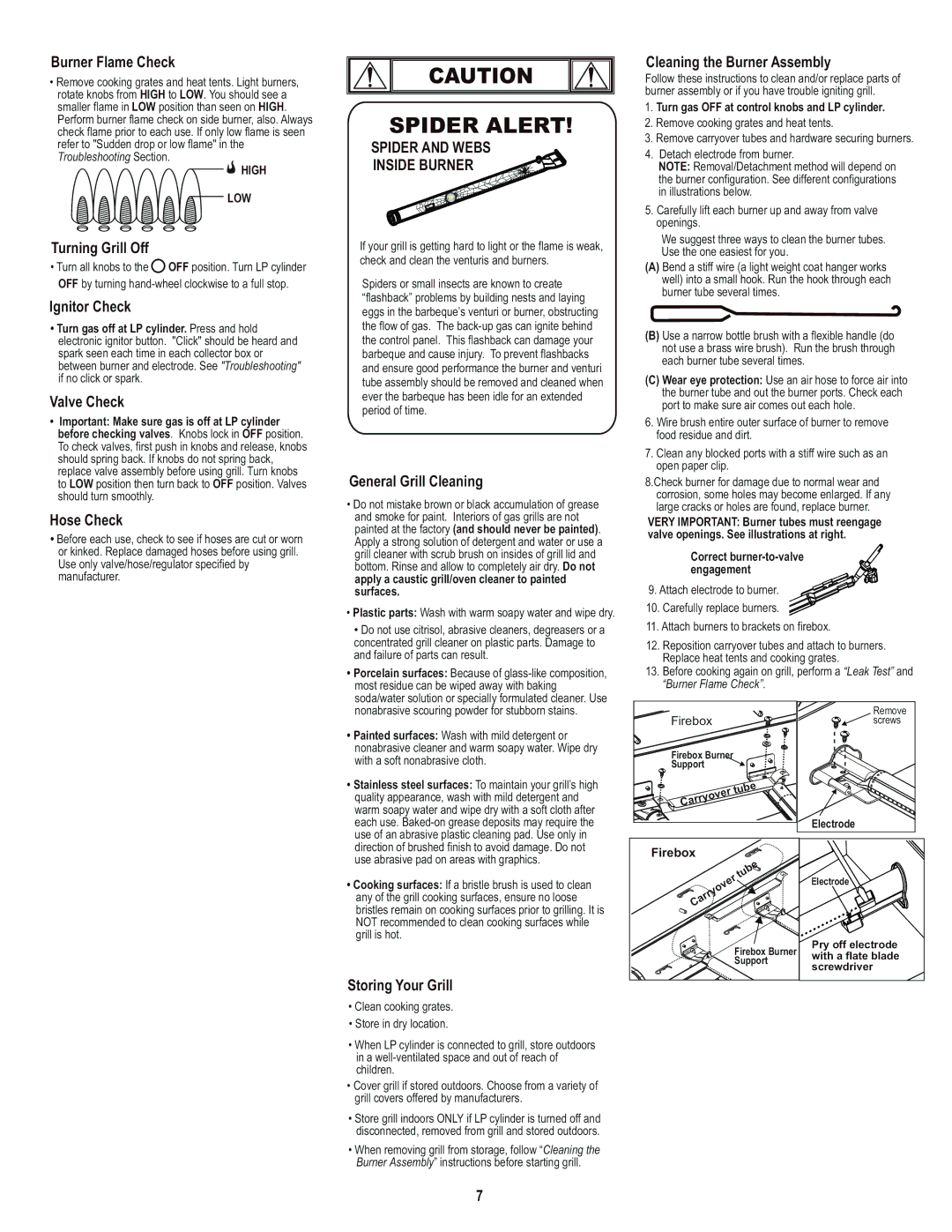
Burner Flame Check
•Remove cooking grates and heat tents. Light burners, rotate knobs from HIGH to LOW. You should see a smaller flame in LOW position than seen on HIGH. Perform burner flame check on side burner, also. Always check flame prior to each use. If only low flame is seen refer to "Sudden drop or low flame" in the Troubleshooting Section.
HIGH
LOW
Turning Grill Off
•Turn all knobs to the ![]() OFF position. Turn LP cylinder OFF by turning
OFF position. Turn LP cylinder OFF by turning
Ignitor Check
•Turn gas off at LP cylinder. Press and hold electronic ignitor button. "Click" should be heard and spark seen each time in each collector box or between burner and electrode. See "Troubleshooting" if no click or spark.
Valve Check
•Important: Make sure gas is off at LP cylinder before checking valves. Knobs lock in OFF position. To check valves, first push in knobs and release, knobs should spring back. If knobs do not spring back, replace valve assembly before using grill. Turn knobs to LOW position then turn back to OFF position. Valves should turn smoothly.
Hose Check
•Before each use, check to see if hoses are cut or worn or kinked. Replace damaged hoses before using grill. Use only valve/hose/regulator specified by manufacturer.
CAUTION |
SPIDER ALERT!
SPIDER AND WEBS
INSIDE BURNER
If your grill is getting hard to light or the flame is weak, check and clean the venturis and burners.
Spiders or small insects are known to create “flashback” problems by building nests and laying eggs in the barbeque’s venturi or burner, obstructing the flow of gas. The
General Grill Cleaning
•Do not mistake brown or black accumulation of grease and smoke for paint. Interiors of gas grills are not painted at the factory (and should never be painted). Apply a strong solution of detergent and water or use a grill cleaner with scrub brush on insides of grill lid and bottom. Rinse and allow to completely air dry. Do not apply a caustic grill/oven cleaner to painted surfaces.
•Plastic parts: Wash with warm soapy water and wipe dry.
• Do not use citrisol, abrasive cleaners, degreasers or a concentrated grill cleaner on plastic parts. Damage to and failure of parts can result.
•Porcelain surfaces: Because of
•Painted surfaces: Wash with mild detergent or nonabrasive cleaner and warm soapy water. Wipe dry with a soft nonabrasive cloth.
•Stainless steel surfaces: To maintain your grill’s high quality appearance, wash with mild detergent and warm soapy water and wipe dry with a soft cloth after each use.
•Cooking surfaces: If a bristle brush is used to clean
any of the grill cooking surfaces, ensure no loose bristles remain on cooking surfaces prior to grilling. It is NOT recommended to clean cooking surfaces while grill is hot.
Storing Your Grill
•Clean cooking grates.
•Store in dry location.
•When LP cylinder is connected to grill, store outdoors in a
•Cover grill if stored outdoors. Choose from a variety of grill covers offered by manufacturers.
•Store grill indoors ONLY if LP cylinder is turned off and disconnected, removed from grill and stored outdoors.
•When removing grill from storage, follow “Cleaning the Burner Assembly” instructions before starting grill.
7
Cleaning the Burner Assembly
Follow these instructions to clean and/or replace parts of burner assembly or if you have trouble igniting grill.
1.Turn gas OFF at control knobs and LP cylinder.
2.Remove cooking grates and heat tents.
3.Remove carryover tubes and hardware securing burners.
4.Detach electrode from burner.
NOTE: Removal/Detachment method will depend on the burner configuration. See different configurations in illustrations below.
5.Carefully lift each burner up and away from valve openings.
We suggest three ways to clean the burner tubes. Use the one easiest for you.
(A)Bend a stiff wire (a light weight coat hanger works well) into a small hook. Run the hook through each burner tube several times.
(B)Use a narrow bottle brush with a flexible handle (do not use a brass wire brush). Run the brush through each burner tube several times.
(C)Wear eye protection: Use an air hose to force air into the burner tube and out the burner ports. Check each port to make sure air comes out each hole.
6.Wire brush entire outer surface of burner to remove food residue and dirt.
7.Clean any blocked ports with a stiff wire such as an open paper clip.
8.Check burner for damage due to normal wear and corrosion, some holes may become enlarged. If any large cracks or holes are found, replace burner.
VERY IMPORTANT: Burner tubes must reengage valve openings. See illustrations at right.
Correct
9. Attach electrode to burner.
10.Carefully replace burners. ![]()
11.Attach burners to brackets on firebox.
12.Reposition carryover tubes and attach to burners. Replace heat tents and cooking grates.
13.Before cooking again on grill, perform a “Leak Test” and “Burner Flame Check”.
Firebox | Remove | |
screws | ||
Firebox Burner |
| |
Support |
| |
tube |
| |
Carryover |
| |
| Electrode | |
Firebox |
| |
tube | Electrode | |
Carryover | ||
| ||
Firebox Burner | Pry off electrode | |
with a flate blade | ||
Support | ||
screwdriver | ||
|
